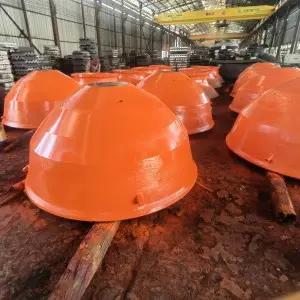The lining plate is the main part of the crusher, but it is also the most seriously worn part. High manganese steel as a commonly used lining material, due to its strong impact or contact with external force when the surface will quickly harden, and the core still maintains a strong toughness, this external hard and internal toughness both wear and impact resistance characteristics in the resistance to strong impact, large pressure, its wear resistance is unmatched by other materials. Here to talk about the impact of the main alloying elements on the properties of high manganese steel.
1, when the carbon element is cast, with the increase of carbon content, the strength and hardness of high manganese steel are continuously improved within a certain range, but the plasticity and toughness are significantly reduced. When the carbon content reaches about 1.3%, the toughness of the as-cast steel is reduced to zero. In particular, the carbon content of high manganese steel working under low temperature conditions is particularly critical, with a carbon content of 1.06% and 1.48% two kinds of steel as a comparison, the impact toughness difference between the two is about 2.6 times at 20℃, and the difference is about 5.3 times at -40℃.
Under the condition of non-strong impact, the wear resistance of high manganese steel increases with the increase of carbon content, because the solid solution strengthening of carbon can reduce the wear of abrasive on steel. Under strong impact conditions, it is usually hoped to reduce the carbon content, and single-phase austenitic structure can be obtained by heat treatment, which has good plasticity and toughness and is easy to strengthen during the formation process.
However, the choice of carbon content is a combination of working conditions, workpiece structure, casting process methods and other requirements to avoid blindly increasing or reducing carbon content. For example, because of the slow cooling speed of the castings with thick walls, a lower carbon content should be selected, which can reduce the impact of carbon precipitation on the organization. Thin-walled castings can be appropriately selected with a higher carbon content. The cooling rate of sand casting is slower than that of metal casting, and the carbon content of the casting can be appropriately low. When the compressive stress of high manganese steel is small and the material hardness is low, the carbon content can be appropriately increased.
2, manganese manganese is the main element of stable austenite, carbon and manganese can improve the stability of austenite. When the carbon content is unchanged, the increase of manganese content is conducive to the transformation of steel structure into austenite. Manganese is soluble in austenite in steel, which can strengthen the matrix structure. When the manganese content is less than 14%, the strength and plasticity will be improved with the increase of manganese content, but manganese is not conducive to work hardening, and the increase of manganese content will damage the wear resistance, so the high content of manganese cannot be blindly pursued.
3, other elements silicon in the conventional content range plays an auxiliary role in deoxidation, under low impact conditions, the increase of silicon content is conducive to the improvement of wear resistance. When the silicon content is higher than 0.65%, the tendency of the steel to crack is intensified, and it is usually desired to control the silicon content below 0.6%.
Adding 1%-2% chromium to high manganese steel is used to make the bucket teeth of excavators and the lining plate of cone crusher, which can significantly improve the wear resistance of products and extend the service life. Under the same deformation conditions, the hardness value of manganese steel containing chromium is higher than that of steel without chromium. Nickel does not affect the work hardening performance and wear resistance of steel, so the wear resistance can not be improved by adding nickel, but how nickel and other metals such as chromium are added to steel at the same time can improve the basic hardness of steel, and improve the wear resistance under non-strong impact abrasive wear conditions.
Rare earth elements can improve the toughness of the deformation layer of high manganese steel, improve the bonding ability of the hardened layer with the underlying matrix, and reduce the possibility of fracture of the hardened layer under impact load, which is beneficial to improve the impact resistance and wear resistance of high manganese steel. The combination of rare earth elements and other alloying elements often achieves good results.
Which combination of elements is the best choice? High stress contact conditions and low stress conditions correspond to different element standard combinations, in order to play the work hardening and wear resistance of high manganese steel.
Post time: Oct-10-2024

